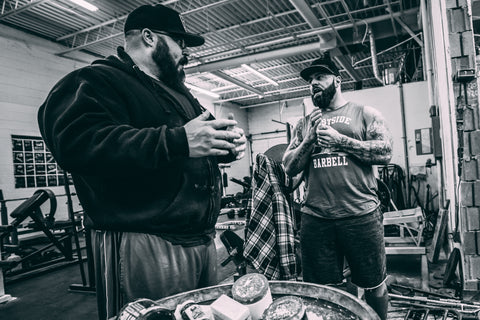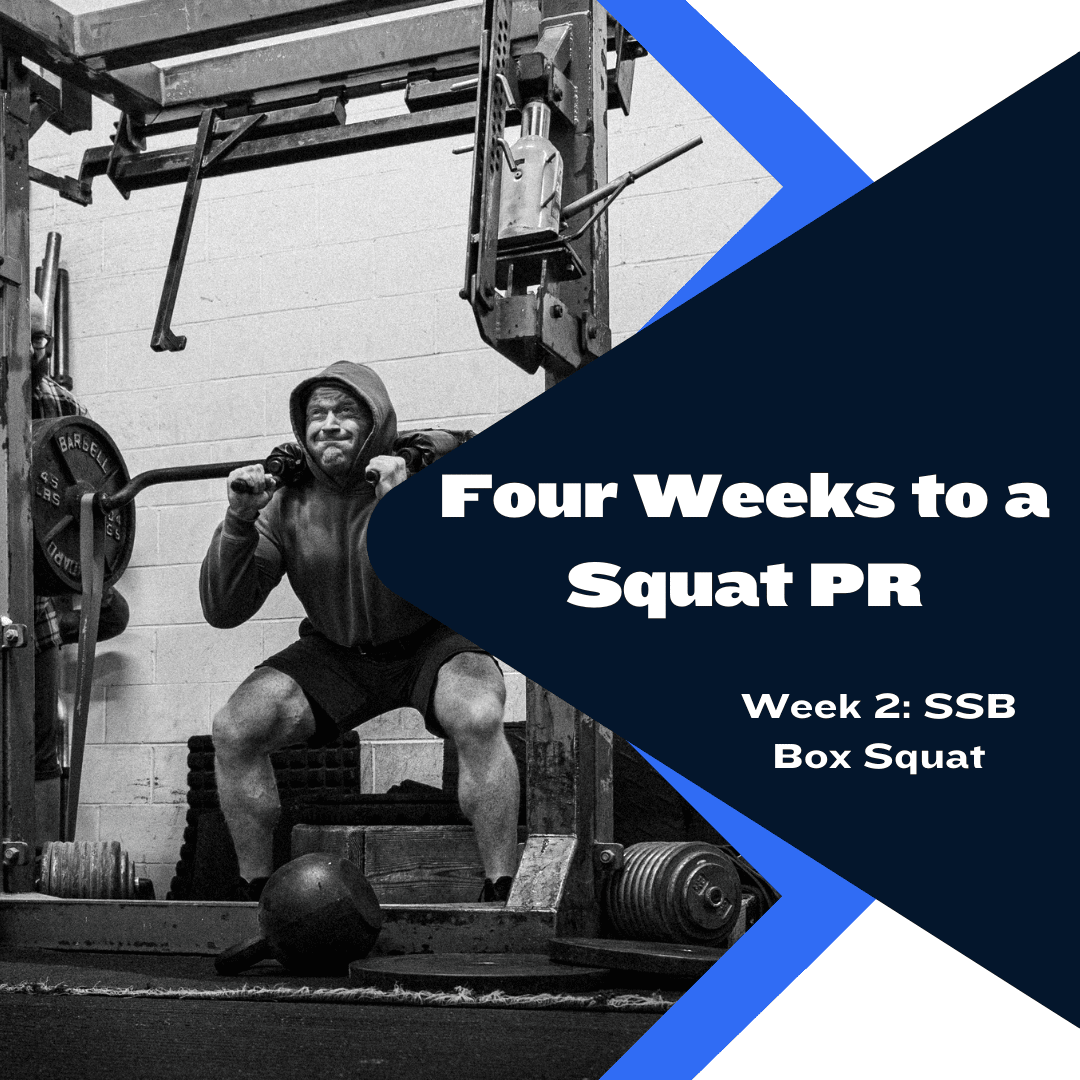Four Weeks to a Squat PR: Week 2

It is now the second week of our four-week squat PR plan. Last week, we performed a 2" mat deadlift, working up to a top-set single. We selected this exercise for two reasons. First, we typically want to perform a deadlift variation once every four weeks. However, with a max effort squat attempt scheduled, we want to ensure we arrive at that day with as little accrued fatigue as possible.
Scheduling the deadlift during week one ensures any residual fatigue caused by a heavy deadlift will be resolved before we attempt to set a new squat PR.
The second reason we selected the 2" mat deadlift is due to the reduced impact this variation has on recovery overall. A deficit or regular deadlift will cause significant strain for most athletes, resulting in 1 to 2 weeks of residual fatigue. However, a mat deadlift gives the athlete a joint-angle advantage, considering the bar is elevated, and the distance to lockout has been reduced.
Keep in mind this may not be the case for all athletes. Occasionally, you may find an athlete who has more difficulty pulling an elevated bar than pulling a regular or deficit deadlift. In this case, the athlete should perform whichever deadlift variation is typically easiest to recover from.
With that being said, here is the training plan for the second week of our four-week squat PR program.
Main Exercise
After the 2" mat deadlift we performed in week one, we should feel fairly recovered as we begin week two. Considering this, we will choose to go with a squat variation that allows some practice reps to work within meaningful ranges of intensity while forcing us to focus on technical execution. In this case, we will perform an SSB box squat for a top set of three reps, aiming for around 90% of our SSB or high bar max on the barbell.
This variation will force an athlete to execute squat reps with as much attention to execution as possible. First, the athlete must deal with the demands the SSB places on squat posture. This will help to reinforce proper bracing and control during the eccentric phase of the squat.

Next, the athlete must sit down to the box with proper technique. This means the athlete sits on the box while achieving a relaxed overcome-by-dynamic and static overcome-by-dynamic training effect. This is only possible if the box squat is performed correctly. Improper technique will reduce or remove these training effects, and the box goes from a useful training tool to a marker for squat depth.
With the combination of the execution-related demands placed on an athlete by both the SSB and box squat, we can quickly identify weak points in our squat. This will allow us to begin attacking these weaknesses immediately, hopefully making for a productive fourth week of training when we attempt our squat PR.
Here is how an athlete planning on a 700lb top set triple would work up when performing this exercise:
Set 1 - 135lbs x 8 reps
Set 2 - 225lbs x 5 reps
Set 3 - 315lbs x 5 reps
Set 4 - 405lbs x 3 reps
Set 5 - 495lbs x 1 rep
Set 6 - 585lbs x 1 rep
Set 7 - 650lbs x 1 rep
Set 8 - 700lbs x 3 reps
As you can see, we follow a work-up pattern similar to the plan we executed last week. When performing a max effort top set, the goal is always to conserve as much energy going into the top set while being as prepared as possible for the top set. In this case, we could reduce the work-up scheme by one set if we chose to take a jump from 585lbs to 700lbs for our top set.
Ultimately, the number of sets and jumps in weight an athlete can tolerate will depend on the athlete's training experience and absolute strength.
The increased warm-up volume makes sense if we are dealing with a less experienced athlete or an athlete just returning to heavy training after some time off. If we are dealing with a strong, well-conditioned athlete, bigger jumps make sense, considering our goal is to conserve as much energy as possible for the top set.
Accessory Exercises
Now that the main exercise has been completed, a good amount of fatigue will likely be present. With last week's heavy deadlift combined with today's heavy squat, we want to ensure accessory exercise volume is regulated appropriately to allow for as much recovery as possible before the third training week of our four-week PR plan.
Our accessory exercise training plan for the second week will feature an average amount of training volume and focus on the quads, hamstrings, and hips. The goal is to hit these muscle groups with appropriate volume to allow for improvements in strength and hypertrophy without causing too much fatigue.
Here are the lower body accessory exercises for week two:
Exercise 1 - Glute-Ham Raise or Inverse Curl, 4 x AMRAP
Exercise 2 - Leg Extension, 3 x 12-15
Exercise 3 - Kettlebell Swings, 3 x 10-12
Exercise 4 - Reverse Hyper, 4 x 15-20.
Exercise 5 - Standing Abs, 4 x 15-20
As you can see, we immediately target the glutes and hamstrings with the glute-ham raises/Inverse Curl. If you have access to both, we recommend using the Inverse Curl because you can complete more reps with less risk of strain. Next, we target the quads by performing leg extensions. Be sure to perform these with intent; do not just go through the motions with your leg extensions.

After leg extension, we moved onto kettlebell swings to further focus on the hips/glutes. We followed up with our usual sets of reverse hypers and abs to ensure our lower back and trunk remained strong and prepared for our upcoming squat PR attempt.
Execution Matters
No matter the exercise you are performing, execution always matters. However, with the box squat, execution not only matters but also directly controls the effectiveness of the exercise. Often, you will see the box squat executed with an athlete just touching the box before initiating the concentric portion of the lift. In this case, the box acts as a marker for squat depth and achieves nothing else.
With proper execution, the box squat provides an athlete with a relaxed overcome-by-dynamic and a static overcome-by-dynamic training effect, leading to significant improvements in the rate of force development. This is the intent of box squat training and what makes the box squat an effective training tool for both max and dynamic effort training.
Additionally, each specialty bar will provide unique training effects and force an athlete to emphasize particular execution points to allow for proper reps to be completed. With the SSB, the athlete must establish and maintain a proper trunk brace while keeping the chest elevated with a neutral thoracic and cervical spine position. Training such as this will help to create good habits that carry over to max effort competition lifts.
Whether performing a max effort squat or a belt squat walk for 60 steps, always strive to execute each rep in a disciplined manner. Not only will you find your training more effective, but you'll also reduce the risk of muscle strains and injuries.
Sources:
Simmons, L. (2007). Westside Barbell Book of Methods. Westside Barbell.
Verkhoshansky, Y., & Siff, M. C. (2009). Supertraining. Verkhoshansky.
Zatsiorsky, V. M., & Kraemer, W. J. (2006). Science and Practice of Strength Training. Human Kinetics





